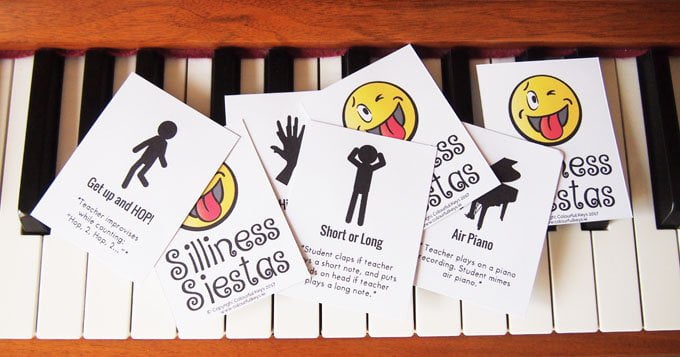
This blog post about helping every piano student develop grit was written by Carmen Carpenter. Carmen has taught music in a school setting as well as in her home studio for 30 years. Teaching combines two of her favourite things: music and kids! Besides teaching music, Carmen loves spending time with family playing games, working puzzles, and watching movies. She is also an avid reader and loves taking long walks on her local, woodsy trails.
Parents want their children to feel confident and successful in their music-making efforts. And teachers want that, too. But sometimes, learning is just hard.

The thing is, it’s okay for music learning to be hard. Actually, in many ways it’s better if the learning is a bit of a struggle – particularly if you want the lessons to stand the test of time.
Experts tell us that struggling to gain long-term learning isn’t just good…it’s necessary. Students who devote time, effort and energy to learning and who experience hardship along the way gain the mental and cognitive tools necessary to make their learning last for the long haul – what we like to call “grit”.
These are the students most likely to become musicians for life.
So how can you help your students who struggle with struggle?
Getting Myself Comfortable With Discomfort
I had an epiphany a while back.
It was a pretty harsh reality check, actually.
I realised that I was just not that effective dealing with piano students who didn’t pick things up easily. That’s not to say that I was impatient with or unkind to these students (at least not at every lesson) or that I fired them from lessons when they rattled my cage.
No, my problem was much more insidious than that. My problem had a lasting negative impact.
My issue?
Giving in way too soon.
When a student complained that something was too hard, I would immediately swoop in and demonstrate and model and baby them. I’d fill in notes, play the rhythm or make a demonstration video. I was even known to back down on some of the things I generally considered “non-negotiables”.

And you know what? The learning of these striving students suffered. Their musical growth was stunted. They didn’t go from being spoon-fed piano babies to knife-wielding piano adults.
And that was on me.
But that’s not the end of the story…
I decided to do something about it. And, no, I didn’t just stop helping my students or teaching them how to learn.
Instead of abruptly quitting my student-whines-teacher-gives-in habits, I made some adjustments that have allowed my students (and me) to get out of that unhelpful cycle.
Adjustment No. 1: Be More Empathetic
Remember what it was like to be a piano beginner? (I know. That’s hard for us older teachers.)
- Listen to your students without judgement or jumping in with advice. Ask open-ended questions about what they’re finding difficult.
- Let the student know you understand that learning and growing can be hard sometimes.
- Tell a story about a time you found something difficult – music-related or not. Talk about how you felt and the strategies you used to get through it.
- Remind the student of something they used to think was hard but is now easy for them.
Showing your student you understand and care about their challenges can strengthen the teacher-student relationship.
A strong teacher-student connection will go a long way as you take steps to move out of the student-complains-teacher-swoops-in pattern.
Adjustment No. 2: Break it Down
Seeing an entire piece all at once for the first time can be overwhelming for students who are struggling – even if it’s just eight bars.
Use post-it notes or highlighters to define which measures or lines or sections you’d like them to practise on particular days of the week. Break their assignment sheet into separate days, and clearly state the parts of a piece they should practise on which day.

Breaking things down in this way might mean that it takes a little longer for a student to master a piece. But what’s the harm in slowing down?
Which brings me to another important adjustment…
Adjustment No. 3: S l o w D o w n
And I’m not talking about the metronome’s tempo (but that’s an excellent strategy as well!).
A struggling student will not do well under the added pressure of rushing to master a piece before they’re actually ready.
I often have to ask myself, “What’s the rush? Why do we need to move forward? What’s the benefit of hustling to finish this book if the next book in the series will be too hard for this student anyway?!”
When I rush the struggling student, they shut down. And sometimes, they give up and quit lessons altogether. 💔
Adjustment No. 4: Progress Over Outcome
Progress in learning, however slow, is much more important than having a finished piece be absolutely perfected (although there’s a time and a place for that too!).
I have two students in my studio, Ellie and Hannah, who are in the same grade at school and have taken buddy piano lessons for about 3 years. Ellie regularly outpaces Hannah on the number of pieces learnt in a year. Ellie also performs at a higher level.
But that’s not the whole story…
Excitable Ellie
Ellie is a speedy learner in every aspect of her life. She excels at school and in her musical endeavours.
When presented with new pieces she’s excited about, she goes home and learns them quite well in a week. (If she doesn’t care for the piece, I often end up having to employ Adjustment No. 7. 👇)
Although this student “learnt” said new piece in a week, it’s when I ask her to polish it for the following week that I lose her.
In fact, at that second lesson, it’s almost as though she never learnt it at all. That’s because she had relied on her previous week’s learning. Since she hadn’t really wrestled with the piece in the first place, the learning didn’t quite stick.
Hardworking Hannah
When Hannah started lessons with me, her mother told me that school was hard for her daughter and she found reading especially difficult.
And sure enough, Hannah struggled to read notes and play rhythms correctly in her first year of piano lessons.
But I honestly don’t think I’ve ever had a harder-working piano student or one with more grit.
I’m convinced that because her early days at both school, and in piano, were so challenging, she learnt to embrace the uncomfortable feelings associated with her struggle to learn.
When presented with new pieces, they can take her weeks – and sometimes a month or more – to master. But she never gives up and NEVER lets me put the piece aside. Throughout the learning process, Hannah demonstrates grit and steady forward-progress on her pieces.
Whose learning do you think will stand the test of time?
I would argue that the student who has fought the hardest to learn and persevered will be a lifelong piano player.
My money’s on Hannah. What do you think?
For more help with motivation and goals, Nicola has an awesome page devoted entirely to Teaching Piano Practice. Check it out!
Adjustment No. 5: Praise Effort
Much like progress over product, the effort is far more important than results. Hard work and grappling with learning have much greater staying power than breezing through pieces and not actually being challenged.
When you notice a student making a great effort to play a new piece or a tricky section, tell them how impressed you are that they’re sticking it out and not giving up.
Praise the piano student grit, not the result.
Let them know their hard work will pay off and, one day, they’ll be amazed they ever thought that section was hard.
Adjustment No. 6: Purposeful Breaks
When I sense a student is nearing their frustration limit, I suggest a break. This is a break on purpose for a purpose.
It is not giving up or giving in to the student’s complaints. There is much evidence to support giving the brain a break during the learning process – particularly when preceded by deliberate effort and struggle.
Sometimes we move on to another part of the lesson plan entirely before returning to that piece, but other times we just do a quick 1 – 2 min. brain break like those from the VMT Silliness Siesta cards. Enter your info below and I’ll send you a sample of the full card deck.

Subscribe to the newsletter and get the Silliness Siesta cards
Enter your details to subscribe to the newsletter for piano teachers with information, tips and offers.
I hate spam as much as you do! I will only send you emails related directly to piano teaching and you can unsubscribe at any time.
Members of Vibrant Music Teaching can download the full deck of Silliness Siestas from the members-only Printable Library. Not a member? Learn more and take a tour to see what you’re missing!
After the break, your student may discover that what was difficult actually got a little bit easier. And even if the hard stuff doesn’t seem simpler, they’ll probably have a more positive outlook after shaking off some of the stress.
Adjustment No. 7: Good Enough
Saying something is “good enough” may sound a little like I’m giving up or giving in, but I’m really not. I’ve discovered it is OK to leave an imperfect piece behind.
Remember Hardworking Hannah from earlier? As long as I had clearly laid out the goals for a piece at the outset, Hannah and I knew when they had been met. With the goals accomplished, we could feel comfortable moving on to a new piece.
When I sense a student is getting overly-flustered in their attempts to polish a piece, I say something like, “This piece may not be perfect, but the goal was reading steps and skips. I know of a different piece that will let you continue to practise that skill. Let’s move on to learn that one now.”
Note: I don’t leave the piece behind simply because a student complains. My own personal rule is that I’ll always have a student work with a piece for at least 3 weeks, and I need to sense some sincere effort before I employ this strategy.
What do you do when students struggle with struggle?
Rather than trying to convince, persuade or cajole these students into believing that struggling to learn is good, could you use one of these 7 adjustments? Let us know how it goes in the comments below.